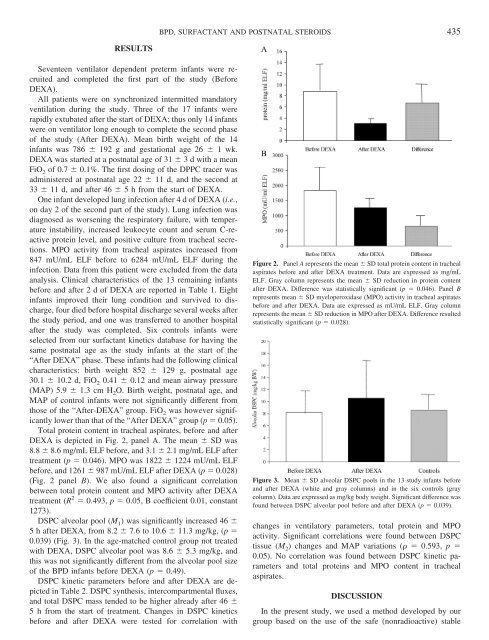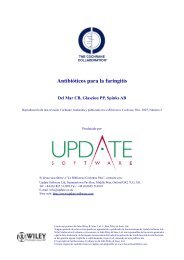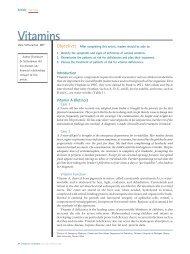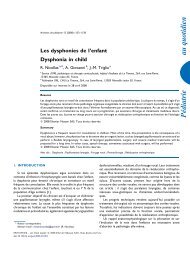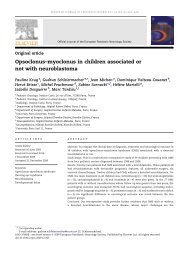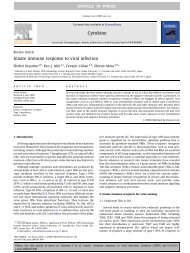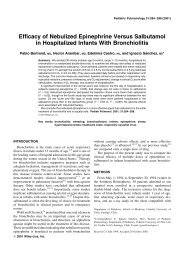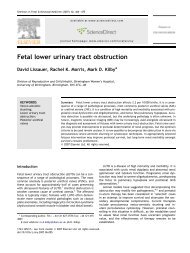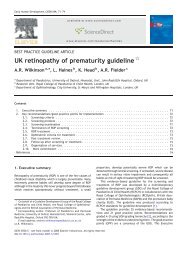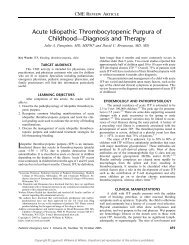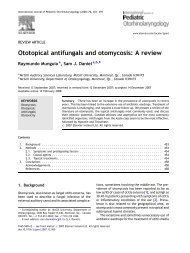Dexamethasone Therapy in Preterm Infants Developing ... - sepeap
Dexamethasone Therapy in Preterm Infants Developing ... - sepeap
Dexamethasone Therapy in Preterm Infants Developing ... - sepeap
Create successful ePaper yourself
Turn your PDF publications into a flip-book with our unique Google optimized e-Paper software.
BPD, SURFACTANT AND POSTNATAL STEROIDS<br />
435<br />
RESULTS<br />
Seventeen ventilator dependent preterm <strong>in</strong>fants were recruited<br />
and completed the first part of the study (Before<br />
DEXA).<br />
All patients were on synchronized <strong>in</strong>termitted mandatory<br />
ventilation dur<strong>in</strong>g the study. Three of the 17 <strong>in</strong>fants were<br />
rapidly extubated after the start of DEXA; thus only 14 <strong>in</strong>fants<br />
were on ventilator long enough to complete the second phase<br />
of the study (After DEXA). Mean birth weight of the 14<br />
<strong>in</strong>fants was 786 192 g and gestational age 26 1 wk.<br />
DEXA was started at a postnatal age of 31 3 d with a mean<br />
FiO 2 of 0.7 0.1%. The first dos<strong>in</strong>g of the DPPC tracer was<br />
adm<strong>in</strong>istered at postnatal age 22 11 d, and the second at<br />
33 11 d, and after 46 5 h from the start of DEXA.<br />
One <strong>in</strong>fant developed lung <strong>in</strong>fection after4dofDEXA (i.e.,<br />
on day 2 of the second part of the study). Lung <strong>in</strong>fection was<br />
diagnosed as worsen<strong>in</strong>g the respiratory failure, with temperature<br />
<strong>in</strong>stability, <strong>in</strong>creased leukocyte count and serum C-reactive<br />
prote<strong>in</strong> level, and positive culture from tracheal secretions.<br />
MPO activity from tracheal aspirates <strong>in</strong>creased from<br />
847 mU/mL ELF before to 6284 mU/mL ELF dur<strong>in</strong>g the<br />
<strong>in</strong>fection. Data from this patient were excluded from the data<br />
analysis. Cl<strong>in</strong>ical characteristics of the 13 rema<strong>in</strong><strong>in</strong>g <strong>in</strong>fants<br />
before and after 2dofDEXA are reported <strong>in</strong> Table 1. Eight<br />
<strong>in</strong>fants improved their lung condition and survived to discharge,<br />
four died before hospital discharge several weeks after<br />
the study period, and one was transferred to another hospital<br />
after the study was completed. Six controls <strong>in</strong>fants were<br />
selected from our surfactant k<strong>in</strong>etics database for hav<strong>in</strong>g the<br />
same postnatal age as the study <strong>in</strong>fants at the start of the<br />
“After DEXA” phase. These <strong>in</strong>fants had the follow<strong>in</strong>g cl<strong>in</strong>ical<br />
characteristics: birth weight 852 129 g, postnatal age<br />
30.1 10.2 d, FiO 2 0.41 0.12 and mean airway pressure<br />
(MAP) 5.9 1.3 cm H 2 O. Birth weight, postnatal age, and<br />
MAP of control <strong>in</strong>fants were not significantly different from<br />
those of the “After-DEXA” group. FiO 2 was however significantly<br />
lower than that of the “After DEXA” group (p 0.05).<br />
Total prote<strong>in</strong> content <strong>in</strong> tracheal aspirates, before and after<br />
DEXA is depicted <strong>in</strong> Fig. 2, panel A. The mean SD was<br />
8.8 8.6 mg/mL ELF before, and 3.1 2.1 mg/mL ELF after<br />
treatment (p 0.046). MPO was 1822 1224 mU/mL ELF<br />
before, and 1261 987 mU/mL ELF after DEXA (p 0.028)<br />
(Fig. 2 panel B). We also found a significant correlation<br />
between total prote<strong>in</strong> content and MPO activity after DEXA<br />
treatment (R 2 0.493, p 0.05, B coefficient 0.01, constant<br />
1273).<br />
DSPC alveolar pool (M 1 ) was significantly <strong>in</strong>creased 46 <br />
5 h after DEXA, from 8.2 7.6 to 10.6 11.3 mg/kg, (p <br />
0.039) (Fig. 3). In the age-matched control group not treated<br />
with DEXA, DSPC alveolar pool was 8.6 5.3 mg/kg, and<br />
this was not significantly different from the alveolar pool size<br />
of the BPD <strong>in</strong>fants before DEXA (p 0.49).<br />
DSPC k<strong>in</strong>etic parameters before and after DEXA are depicted<br />
<strong>in</strong> Table 2. DSPC synthesis, <strong>in</strong>tercompartmental fluxes,<br />
and total DSPC mass tended to be higher already after 46 <br />
5 h from the start of treatment. Changes <strong>in</strong> DSPC k<strong>in</strong>etics<br />
before and after DEXA were tested for correlation with<br />
Figure 2. Panel A represents the mean SD total prote<strong>in</strong> content <strong>in</strong> tracheal<br />
aspirates before and after DEXA treatment. Data are expressed as mg/mL<br />
ELF. Gray column represents the mean SD reduction <strong>in</strong> prote<strong>in</strong> content<br />
after DEXA. Difference was statistically significant (p 0.046). Panel B<br />
represents mean SD myeloperoxidase (MPO) activity <strong>in</strong> tracheal aspirates<br />
before and after DEXA. Data are expressed as mU/mL ELF. Gray column<br />
represents the mean SD reduction <strong>in</strong> MPO after DEXA. Difference resulted<br />
statistically significant (p 0.028).<br />
Figure 3. Mean SD alveolar DSPC pools <strong>in</strong> the 13 study <strong>in</strong>fants before<br />
and after DEXA (white and gray columns) and <strong>in</strong> the six controls (gray<br />
column). Data are expressed as mg/kg body weight. Significant difference was<br />
found between DSPC alveolar pool before and after DEXA (p 0.039).<br />
changes <strong>in</strong> ventilatory parameters, total prote<strong>in</strong> and MPO<br />
activity. Significant correlations were found between DSPC<br />
tissue (M 2 ) changes and MAP variations ( 0.593, p <br />
0.05). No correlation was found between DSPC k<strong>in</strong>etic parameters<br />
and total prote<strong>in</strong>s and MPO content <strong>in</strong> tracheal<br />
aspirates.<br />
DISCUSSION<br />
In the present study, we used a method developed by our<br />
group based on the use of the safe (nonradioactive) stable


